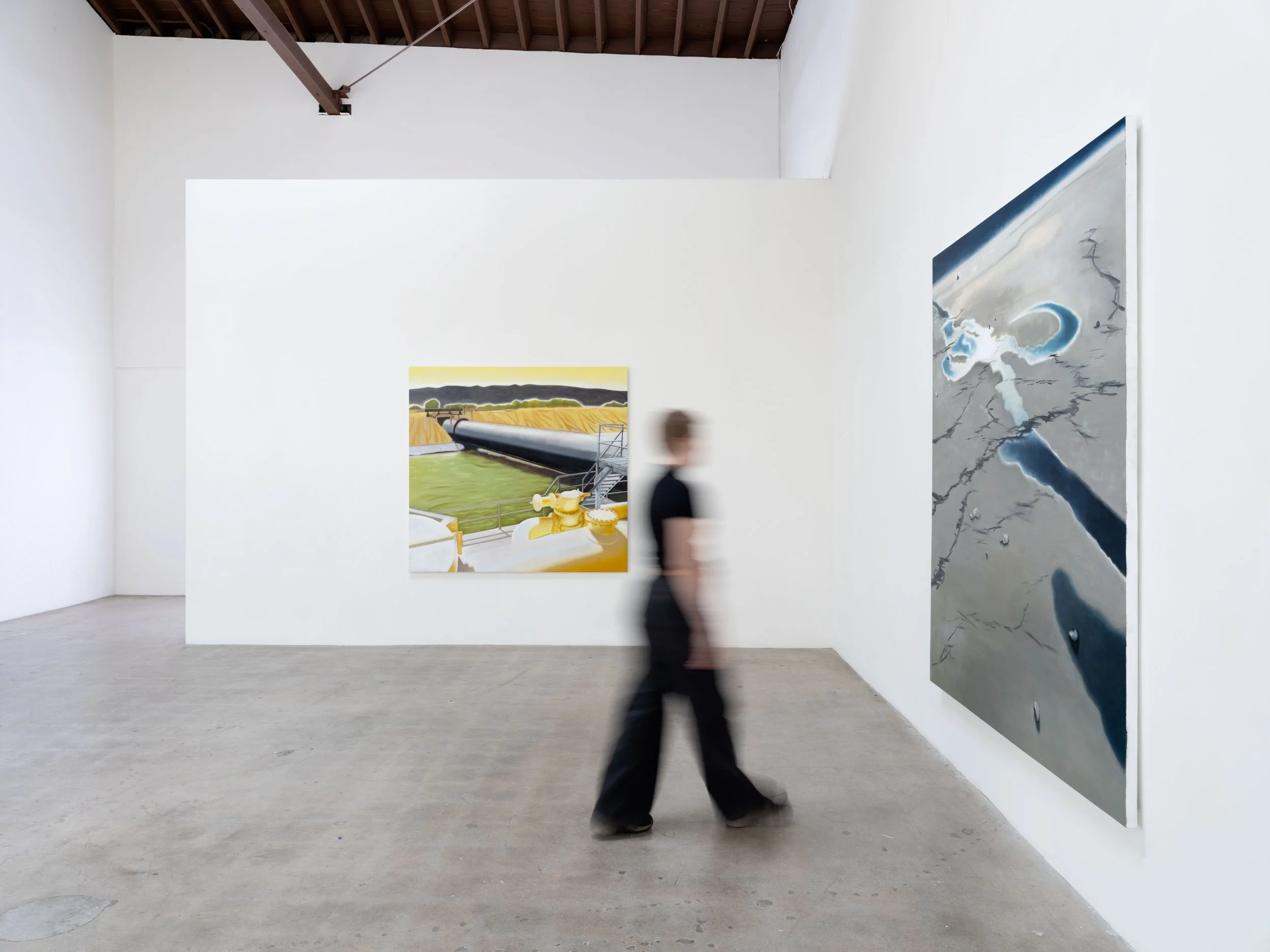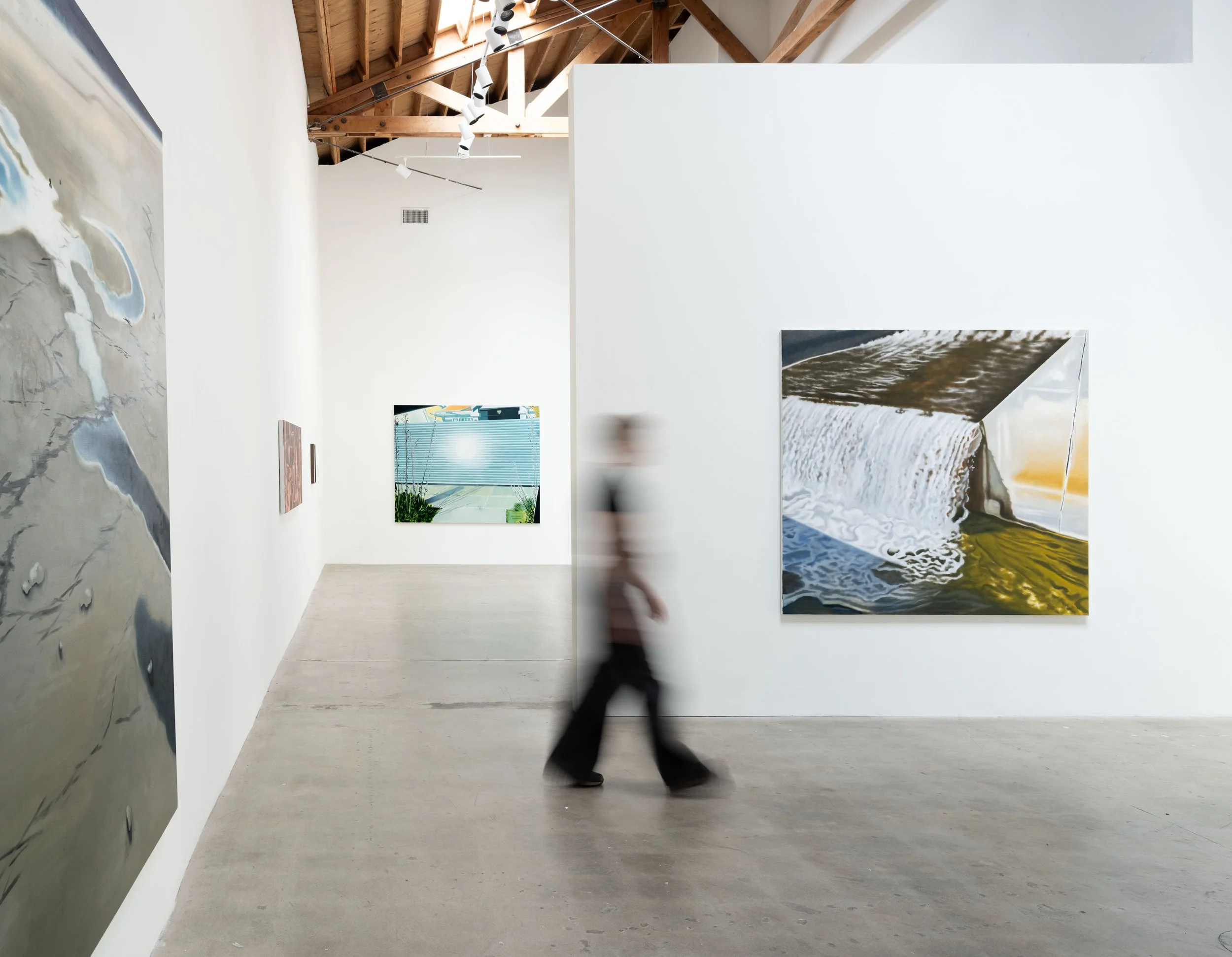Luke Rogers
works exhibitions news about
coughing in the pipes
September 13 - October 25, 2025























exhibition text
“Water is important to people who do not have it,” Joan Didion wrote, “and the same is true of control.” She was talking about California, and the impressive machinery–“the aqueducts and siphons and pumps and forebays and afterbays and weirs and drains”–that has, since the early 20th Century, made American life as we know it to be plausible in the West. Those means of control are the subjects of Luke Rogers’ new paintings, a body of work that traverses the distance between dams in Oroville and Antelope Valley, the Jawbone siphon in the Sierras, the Los Angeles aqueduct, and the sink in his studio. Both plumbing and what Didion calls “plumbing on a grand scale”: the system of pipes, big and small, that deliver drinking water to his glass.
Taken from her 1977 essay, “Holy Water,” Coughing in the pipes is how Didion describes the sounds of a well that has gone dry. In the world of Rogers’ paintings, the phrase evokes alarm sounding beneath the image, a sense that something is going terribly wrong. Even before we see the title of Flood, what appears to be an overflowing sink also conveys, in the paisley of light swirling across a black pool, a greater landscape of disaster. Rogers moved to LA nearly a decade ago, and has made it his chosen home. Questioning the utilities and structures that make the city habitable is one of the ways he has naturalized himself to the place. That experience lends the intimation of disaster in his work an unassuming quality, a truthfulness. They are not ‘about’ global warming, they simply live with droughts and wildfires and earthquakes, as everyone in California does. His work is essayistic in this way, a vision of ‘normal life’ during ecological catastrophe, rooted in a personal conflict between painted material, his eye, and his hand.
His formal and conceptual approach is one of minimizing the difference between things, giving ostensibly disparate subjects - clothes tumbling in a dryer, a pot of boiling water, dams, shipping containers - equal weight. In Oroville, sheets of water descending the dam are as sturdy as the manmade systems that harness and apportion them. The network of pipes he finds at home are as substantial as the 200 meter pipe that carries water from the eastern part of the state to the city. Meanwhile, in Concrete. Water. Dirt, vaporous sprays dissolve into the air with the same soft power as light sunburning concrete, or gleaming on copper pipes in Plumbing, or concentrating into a globe of heat in the center of a metal gate in Harcourt. To render sameness between things we might believe to be contradictory is part of the ecological awareness Rogers brings to looking, never quite differentiating the part from the whole, the object from the environment, the sink from the dam.
Each artist endures successive educations, formal or informal, that complement, revise, affirm, or erase their earlier lessons, earlier selves. In LA, Rogers has learned a way to synthesize these different selves without entirely resolving them on the surface of the painting. This is part of what makes them so compelling. He shows us the conflict between his hand’s unconcealed markmaking and an omniscient vision averse to the hand. His color searches to describe experience, yielding unexpected feeling from his source materials: his palette, which tends away from major-chord primaries toward the more unsettled minor chord, can tilt greens and yellows sickly or lurid, and bridges the cheery brightness of California with the unnatural and surreal darkness of wildfire smoke. Then there is the question of control itself. Rogers seemingly finishes and unfinishes the painting at once, giving tangible, weighty shape to his images and then letting them, at times, fall back into the mere physicality of paint, moments where brushstrokes, drips, and thin washes betray the illusion of the painting’s image. In this deference to the possibilities of paint, as well as in his subject matter, Rogers recalls Courbet’s series of grotto paintings from the 1860’s, The Source of the Loue, which are as much about the dynamism of the eye - how paint can capture the experience of looking - as they are descriptions of a ramshackle mill and adjoining infrastructure, rough-hewn rocks, trees, and water.
In Rogers’ approach, we find a dialectic between what a painting is and what it could be. Each thinking-doing that is the act of painting becomes a proposition to be contradicted by another mark, another decision, a conflict that might lead us toward some truer vision of the world. That this process is, to an extent, undisguised, allows irresolution to be constituent of his subjects. In the seeing-feeling-thinking that is beholding his paintings, we are prompted to wonder: what is the world? What could it be?
Almost a decade before “Holy Water,” in 1970, Didion gave an account of her tour of the Hoover Dam. The Bureau of Reclamation guide clarifies the image she has been trying to fix in her mind: of the dam transmitting power and releasing water long after humans are gone, “a dynamo finally free of man.” In the peopleless world of Rogers’ paintings we find such an image. All that is left of the force of human activity are its consequences.
Henry Chapman
August 2025


